Purslane: A Magical Summer Herb and Notes on Some Research on Oxalates
Common purslane (Portulaca oleracea) is a summer herb in South Africa. Or more specifically, end of September to the beginning of November, depending on the rain, you can expect purslane to start popping up. This is one of those so-called weeds most people in my country cannot stand. Growing proliferous on the sides of roads or in driveways, many a gardener struggles year after year to rid this plant from their gardens. But I think this struggle is useless as a single purslane plant can produce up to 6 700 seeds. Yes, you read correctly. Almost 10 000 seeds per plant. And these plants grow together in clumps. You can see the problem.
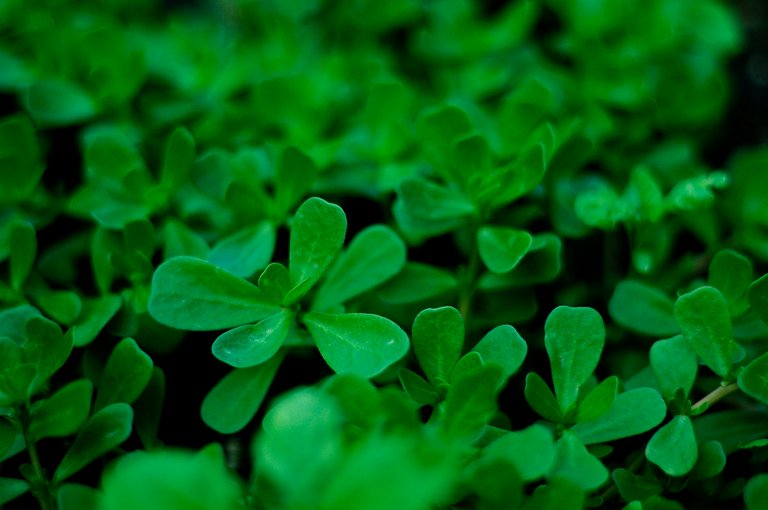
However, the common purslane is one of the most nutritious plants out there. This is a very heavy claim to back up, but I will try to showcase this throughout my post. I love this herb for its nutritional content, but also for the sheer volume it grows in tough conditions (i.e. little water, wind, very warm weather, and so on). But, and this is a big BUT, this plant is one of those that has higher oxalate content. If you have a problem with this, please do your own research and if you can safely enjoy this herb.
In any case, in this post, I will introduce some scientific studies' findings on the health benefits of purslane as I find it interesting that this is one of the healthiest plants that few eat. I will also reflect on some studies that showcase how to eat food with high oxalate content. I will accompany this with two or three recipes in which you can use these neat tricks that studies have shown to be effective to get rid of almost two-thirds of oxalates. Lastly, I write a little on how I grow purslane. So, please do read on if you want to learn about this awesome herb that most people look over!
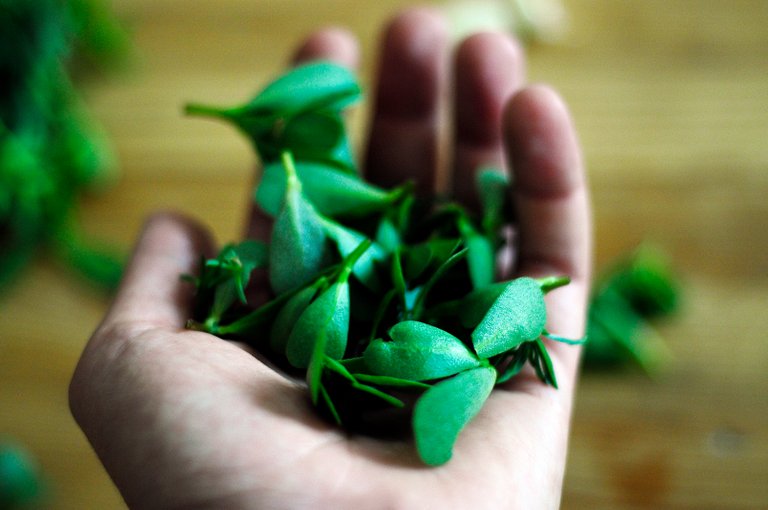
Science, Food, and an Unhealthy Mindset
I think the author Michael Pollan in some of his talks and books took the idea of nutritionism to a very interesting conclusion: we need scientists to tell us what is healthy in food before we think that it is healthy. But determining how healthy food is, especially regarding macronutrients, is very difficult. That is, we know that vitamin C is very important, but isolating it into a pill form and giving it orally is not always backed by conclusive data. The takeaway from Pollan and others is that if we reduce food to its individual components, we need scientists to tell us what is healthy to eat. And my own thoughts about this is basically that it is too dystopian and scary to think about a world in which we need people in labs telling us what is healthy and subsequently growing food in labs, and so on.
But, science can help us to understand things more in-depth and basically confirm what we already knew. One such topic is oxalates. I discuss this more in-depth below, but basically what I read (studied) thus far and could find out is that oxalates are dangerous (in high amounts) but they pretty easily bind to things like calcium. If herbs with high amounts of oxalates are eaten with, say, calcium-rich food, or if the herb itself contains high calcium amounts, it is generally safe to consume. (A word of warning: (i) do your own research, and (ii) I am a philosopher reflecting on what I have read. Take everything I say with a pinch of salt!) But more on this below.
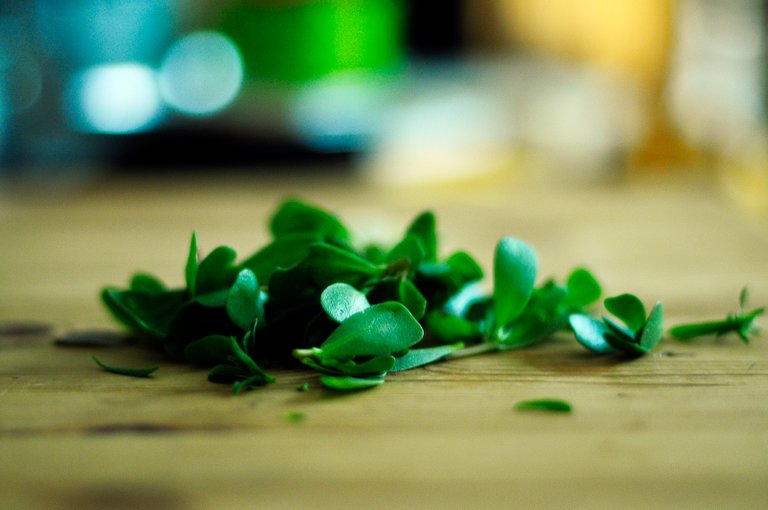
I think this is a very dangerous and unhealthy mindset. Rather than focus holistically on food and herbs, we will begin to break down food and herbs into their nutritional content. The problem with this is that the science is not conclusive at this stage and various growing conditions will influence the herbs you eat. If you grow your own herbs from compost you made, I think it will be very different from herbs grown in hydroponics in a lab. I can be wrong! But this is just the mindset I follow. Transgressing my own advice on not breaking herbs down into their individual content, let us look at some of the studies.
Purslane is very high in potassium, magnesium, and it's one of the leafy herbs you can use that actually has omega-3 fatty acids. According to a recent 2020 study, purslane is a herb with potentially
the richest source of a-linolenic acid, essential omega-3 and 6 fatty acids, ascorbic acid, glutathione, a-tocopherol and b-carotene.
However, as noted, most studies warn that purslanes oxalate content or oxalic acids are very high.
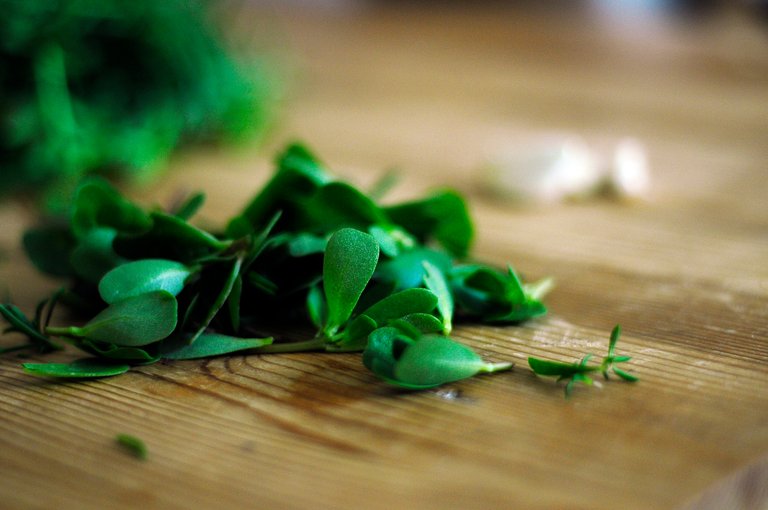
There are also various medicinal uses of purslane. However, consult your doctor before using herbs as a primary source of treatment. Medicinal herbs can help but they can also make things worse if you do not know what you are doing. This is a bit off-topic, but I believe the medicinal application of herbs or herbalism is coming back into mainstream culture but as with normal medicine, we need lots of knowledge and collaboration. So, be cautios. In any case, according to Plants for a Future, purslane has been used in the past as an:
antibacterial, antiscorbutic, depurative, diuretic and febrifuge.
Due to its high amounts of omega-3 fatty acids, it can also be healthy for your heart. But let us move on to some interesting studies on oxalates.
Oxalates, Vinegar, Yoghurt, and Fermentation
I think most people are aware of the breakdown of oxalates when boiling or cooking leafy greens. Spinach is a great example. But my problem is I want to use various leaves, like purslane, in salads. You cannot use blanched leaves in a salad, even though a third of oxalates might be destroyed. However, I stumbled onto some interesting research. (Here is a blog post that sums up most of the articles; but here is the first study; and here is the second study.) Basically what these studies claim is that certain types of foods render oxalates safe to consume. The most promising is that of yoghurt. I know a lot of people in herbalism can be vegan, and there is the option of coconut milk/cream. However, the effects are not as good as with cow's milk yogurt. The one study claims that
The soluble oxalate content of the raw leaves was 53.0% which reduced to 10.7% when yoghurt was added to the leaves.
If you are a lover of tzatziki sauce, you can totally swap out 50% of your cucumber for purslane leaves! But there are vegan or plant-based options as well! Another study finds that the bacteria in sauerkraut does the same job. This is awesome news. Yet another option is to simply use vinegar. And this is what I did in the recipe below. A study showcased that up to 15% of oxalates are destroyed in the pickling process. Without further ado, on to the recipe!
Cooking with Purslane
There is a potential elephant in the room. Purslane is not like other leaves. It is slightly slimy and can be strange to people who are not used to it. Apparently, it can be used in soups where you would have used okra to thicken the soup. But as mentioned, this is a summer herb for me and I thus opt to use it in salads. Or stated differently, it is too warm for hot soups! (Maybe I should put it in a gazpacho!) But using one of the techniques mentioned above, I simply made a type of chimichurri sauce that I want to use on a salad. I use lemon juice for a quick pickling; I hope it does the same as vinegar!
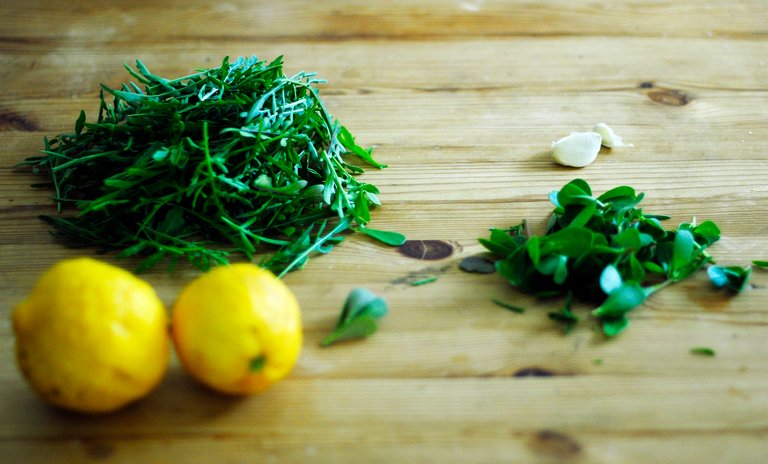
I chopped all of the ingredients fine and added the lemon zest as well. I added some olive oil too. I mixed it with some wild rocket leaves and garlic. It was so good! And I think an interesting way to use the purslane.
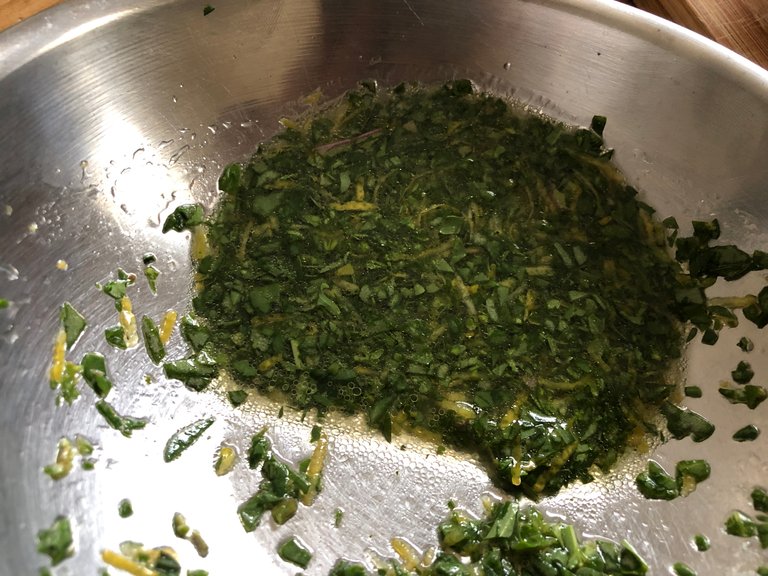
Another way to use purslane, is to simply use it like you would have used any leaves. As noted, the oxalate content might be high, but as mentioned at the start of the post, some claim that the high amount of calcium makes it safe to eat raw. So, I use it on a sandwich with wild rocket, tomatoes, peppers, and cucumber.
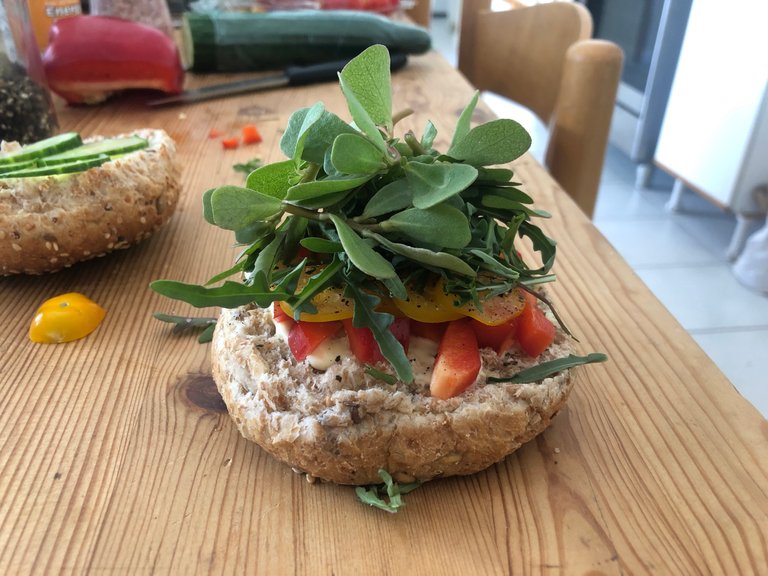

Growing Purslane
In this last section, I want to briefly give you an idea about how this herb grows and why people label it as a weed. It is a very quick-growing herb and it grows a very deep root. The seed pods will only show up later in the growing season. What some people do is to uproot the whole plant, let it dry out in a bowl, and this drying out will open the seedpods. You will never run out of purslane seeds! As mentioned, there are thousands per plant. The seeds are very small. And they lay dormant throughout the winter months in the soil. Normally, I just let the plants self seed, but I planted some seeds in my compost-rich soil garden bed in full sun. Here is three images, from sprouting and first leaves, till this morning with the plants being very big.
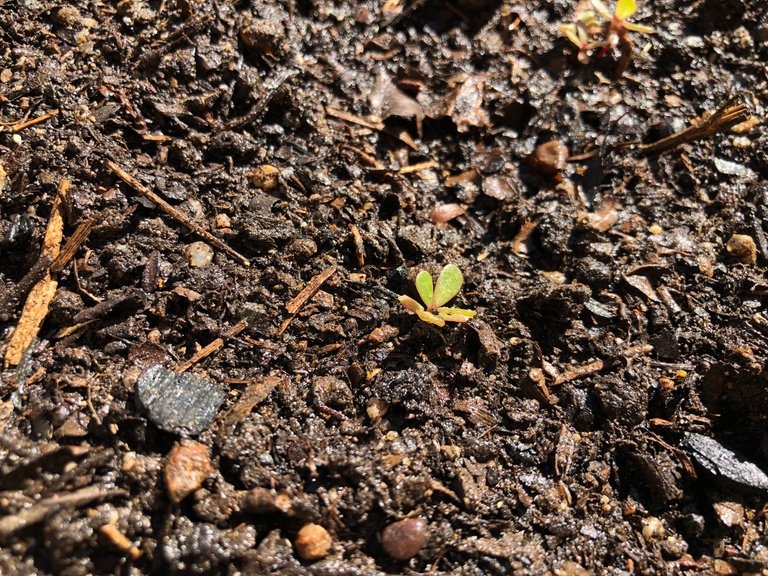
(Image taken on 10 November)
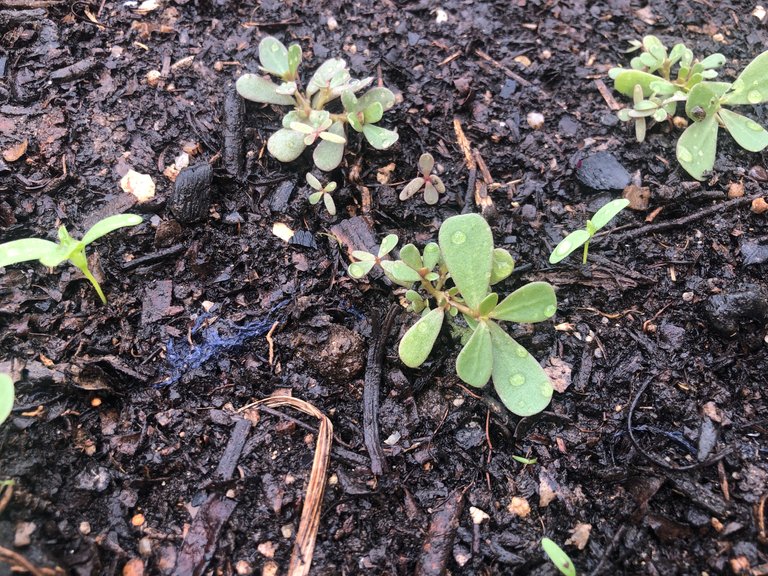
(Image taken on 16 November)
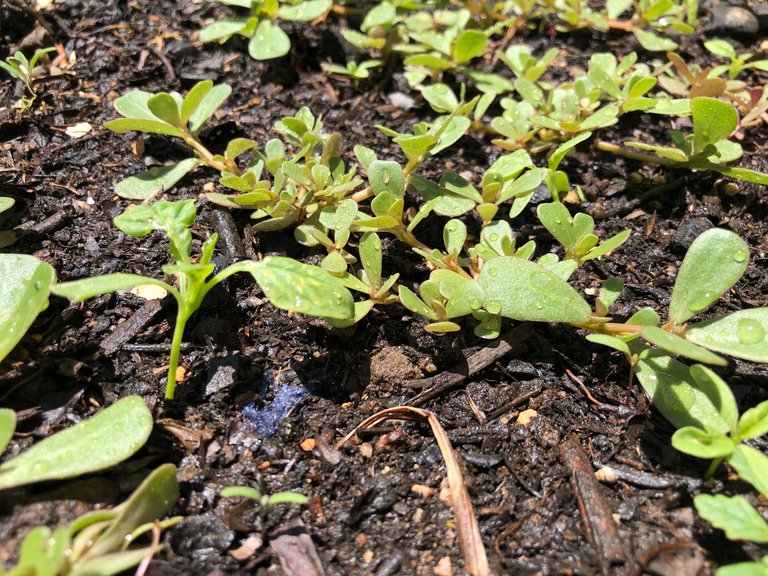
(Image taken on 21 November)

(Image taken on 27 November)
So, growing this herb is very easy. It is drought tolerant. If you do not water it (i.e. if you do not use it as a herb and it is really a weed in your pavement) the leaves will be smaller and the seedpods will develop quickly. If you do water it and use it as a herb the leaves will get very big and will be awesome for your salad (if you do use it as a salad!). As mentioned, you can use it in any type of sauce, like pesto, chimichurri, tzatziki, and so on. I also make a "dirty rice" in which I use purslane. The recipes are endless, be creative!
A Last Word
I love this herb. It is the signal of summer. It is almost a religious herb, the symbol that things come back after death (in plant terms). The seeds are so small, but they grow so big. I hope that you enjoyed this post and that you learned something new. Do experiment, safely, and be creative. Life is beautiful. All the musings in this post are my own unless credited otherwise. The images are also my own, I used my Nikon D300 and iPhone.
Have you ever cooked with purslane? Please let me know. I would love to hear how you use purslane in your cooking.
Wow - that's fascinating about vinegar or yoghurt neutralising/reducing the oxaliates. as I was reading I immediately thought - ooh, purslane tzatziki! Snap! Great post. Thanks for taking the trouble to write it. It'd be awesome in pesto, too.
Thanks for stopping by! Indeed, I love to add it in pesto. And I am so excited regarding the tzatziki! Or even a Labneh dish, something Lebanese. Thanks again! 🤗
As with spinach, the thing would be to boil the leaves and discard the cooking water to get rid of nitrites and oxalates. I am one of those African cooks that makes a base of onions and tomatoes and then adds the cooked green vegetables such as marogo, spinach, pumpkin leaves. I have tons of purslane and was wondering how best to prepare it. Thanks for the headsup about oxalates
Glad the post helped! Same here, I love to cook with all those leaves. I have never really tried the pumpkin leaves though. I need to give that a try!
Just remember that only young leaves and shoots are edible and you need to strip the spiny parts as shown in the video here https://youshouldgrow.com/pumpkin-leaves/ After that, they are very tasty
Oh thank you so much for this! I will go and check it out. There is always pumpkin growing from compost heaps, so why not use it a bit more productively.
After getting half way I was really confused. I had to go back and check your title. I was so caught up by the OX....part that I didn't realize that you weren't jumping the Oxymel bandwagon like so many of us health foodies! Purslane tzatziki sounds amazing. But now my imagination has run away with me. Purslane is not something I reach for unless it is to pull it out of my herb gardens when it takes over. Now imagine an oxy overdose in oxymel! You should definitely go for it! Think of all those yummy wild herbs that you can ferment to drizzle over hot sourdough bread @fermentedphil. Yummy!
Oh yes! I will do this. I wanted to get on the bandwagon but these couple of days or weeks have been so hectic. I am mostly in any case always the last one with bandwagons 🤣 But I am in agreement with you. Fermented wild herb drizzle over a sourdough ciabatta 😍 where can I buy time??
Yes, my wife and I are lovers of tzatziki dip and associate it with summer, when we had our own garden. Thank you, brother, for honoring what we ingest into our system and reminding us of its healing / sacred dimension. It’s amazing to consider how Nature is an an open-air pharmacy & all science does is to discover/uncover what already is…
What a world of marvels & countless blessings 🙏🏽✨
I agree with this statement so much! Science is there to corroborate or disprove what we already knew.
Thank you so much, my friend! Small pieces of a larger puzzle, or let me rather say, we do small things that in themselves do not look like it fits. But when we stand back there might be a bigger puzzle in the works.
Stay safe and all the blessings to you too, my friend. 🌸🙏
Superb Article! ❤️ I love your style how you present it.
Great recipe. Thanks for posting.
Thank you so much! I really appreciate you stopping by! Always a wonderful surprise.
You can't go full on scientist, denying its holistic values to purslane, for then stabbing me in the back at the end, coming up with such a beautiful metaphor about death and life, that sums up a very well crafted article!
Oh and Tzaziki is my all time fav! So, kudo on that too!
All in a day's work 🤣. I get this type of critique from so many colleagues and people who read my academic publications. The lack of perspective in my writing is at once very frustrating and also (according to them) a very negative attribute. Alas, here I am checking things out from various angles.
There we go! Add some purslane to the tzatziki! Do let me know when and if you ever try it!
Thank you for the presentation on this one! 😌
It is always such an honor that people read! Thanks so much, I really appreciate it.
we have this weed everywhere and we are not really paying attention.. And now I know, thanks for this article. Very informative. we'll do more research re this..
I am glad that you found the post informative! Really appreciate it. Yes, do some research and see what you find! Always fun to discover new things.